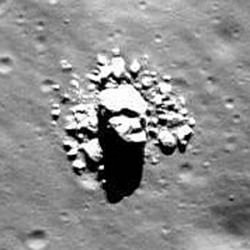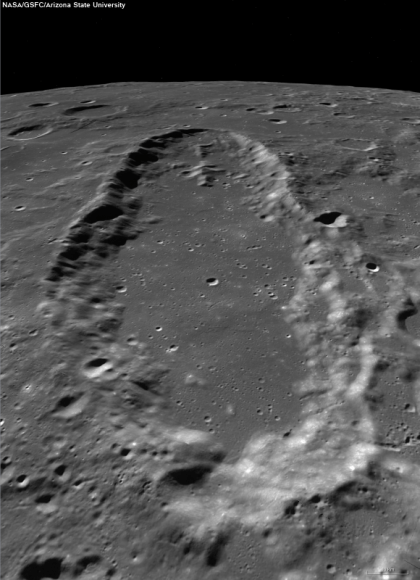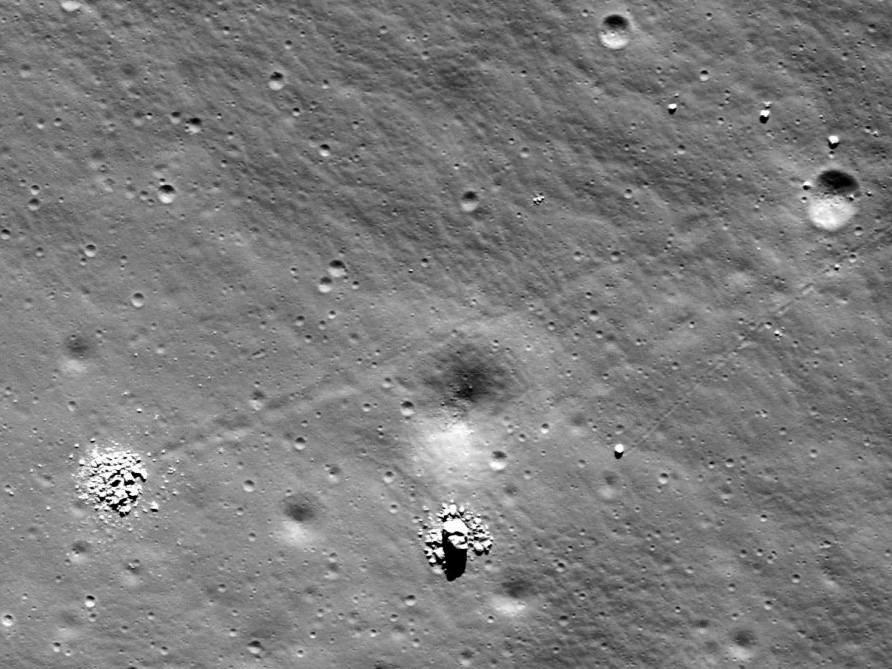[/caption]
Breaking up may be hard to do, but these two lunar boulders seem to have succeeded extremely well! Imaged by the Lunar Reconnaissance Orbiter Camera (LROC) in October of 2009, this crumbled couple was recently identified by Moon Zoo team member Dr. Anthony Cook and brought to the attention of the project’s forum moderator.
The tracks left in the regolith — lunar soil — behind the boulders tell of their past rolling journeys down the slope of the elongated Schiller crater, in which they reside. Rolling boulders have been spotted before on the Moon, but what made these two split apart? And…why does that one on the lower right look so much like half a face?
Several things can cause lunar boulders to come loose and take the nearest downhill course. Meteorite impacts can shake the ground locally, giving the rocks enough of a nudge to set them on a roll. And moonquakes — the lunar version of earthquakes, as the name implies (although not due to tectonic plate shifts but rather to more mysterious internal lunar forces) — can also dislodge large boulders.
The low gravity on the Moon can make large rocks take a bounding path, evidenced by the dotted-line appearance of some of the trails.
Could all that bounding and bouncing have made the two boulders above shatter apart? Or was something else the cause of their crumbling?
Dr. Cook suggested that the boulders could have fractured before they began rolling, and then the added stress of their trip down the crater’s slope (uphill is to the right) made them break apart at the end of their trip… possibly due to further weathering and the extreme temperature variations of lunar days and nights.
Although a sound idea, Dr. Cook added, “I’m a bit puzzled though why the one on the top left has rock debris so far away from the centre. The boulder that looks like a skull rock on the bottom right has debris a lot closer to it, that could simply be explained by bits falling off as one would expect from the explanation above.”

Another idea is that the boulders were struck by meteorites, but it seems extremely improbable that two would have been hit right next to each other. Still, not impossible, especially given the geologic time spans in play.
And as far as the “skull rock” boulder is concerned… that’s a little something called pareidolia, the tendency for our brains to interpret random shapes as something particularly significant. In this case it’s a human face, one of the most popular forms of pareidolia (perhaps best known by the famous “Face on Mars”, which, as we all now know, has been since shown to be just another Martian mesa.)
It does look like a face though, and not a particularly happy one!
Find out more about rolling boulders and Schiller crater on the LROC site hosted by Arizona State University here, and take a look at the full image scan of the region yourself… you may find more of these broken-up rolling rocks!



There’s another face in this same image. It’s looking left along the left side of the shadow of the mean looking one. Kind of clownish or Howdy Doodyish. 😉 I even see one in the pile of rubble of the other boulder. AAHH! Faces everywhere! Cool article, btw!
The boulder in the upper left looks like the face of a jester !!
I think the big question here is if there’s any moss on these rolling stones?
Probably it shattered when a formerly cold and shadowed part of the boulder heated. You might not need ice inside to do that but if you take a rock from an icy creek to line your campfire with, you can get mighty surprised when it suddenly splits.
Its name is Ozymandias.
Masons.
Lunar artisans is the most parsimonious explanation.
It was pan dimensional future humans destroying statues to eradicate evidence that the Reptilians could use to incriminate the controllers of the solar system’s comets electro-dynamos… Just ask Dick Hoagland!
I agree with the possibility that small meteorites hit the boulders. Judging by all the pock marks in the vicinity, this is entirely likely. And based on the settling of the dust in the boulder trails, I think the bottom right boulder rolled first. A heavier meteorite probably hit the top left boulder, thus greater shattering.
Negative boulder thinking: …oO( I’ll never fly this airline again )
Maybe they just hatched?
One step closer to freedom for this Lunar devil. Soon we will witness it’s wrath. Who can stop it?
*sigh* Sometimes, I wish life was more like comic books.
Let the internet conspiracy rumors begin: Scientists find shattered statue on moon. That’s about two notches below “Face of Jesus Seen on Taco Shell.”
It does look like Donald Trump, who probably has already purchased the moon for his next hotel.
Meteorite hits make no sense. Check the perfect symmetry. They might chip off a bit off one side or blow up the whole thing but not create two identical crumble zones within 50 metres. No, this is clearly erosion based on expanding gases within rocks that were formerly protected under regolith. One is just faster than the other and the face will soon go the same way.
Hmmm I don’t agree that it’s “clearly” that… when it seems to experts are themselves baffled 😉
It sounds like a reasonable explanation, but how deep within the rock would heat penetrate to cause gas to expand? I can only imagine gas expanding near the surface, which would break off small pebble0sized pieces of rock, not big lumps. Also, gas is pretty good at being compressed, so i doubt it would really exert that much force on the surrounding rock.
It could well be the correct explanation, but to me at least, it needs clarifying.
how did you know that the boulders came from schiller crater?
Non Non Non – you’re all wrong dammit.
That’s an ONI-Mask – It’s the Lunar-Oni-Mask from ancient Chinese legends!
Finally, watching Cartoons (Jackie Chan!) has taught me something!
On a more fun and serious note – I can’t actually see the “Face” it’s talking about 🙁